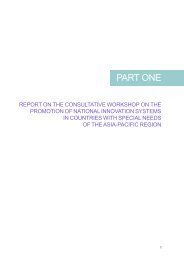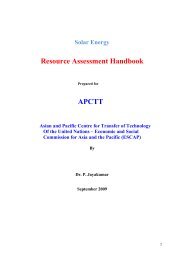Download Complete PDF - apctt
Download Complete PDF - apctt
Download Complete PDF - apctt
- No tags were found...
Create successful ePaper yourself
Turn your PDF publications into a flip-book with our unique Google optimized e-Paper software.
cooperation will be essential in some technology areas, and developed countries willneed to provide the lead in low-carbon technologies. A major effort to realize this wouldbe required at the level of both the government and the industry.WEC has projected that decades will be required, even with the most effective applicationof policy and technologies, to achieve significant sustainable reduction in CO 2emissionsfrom the world’s energy economy in large part because of the time and cost involved inreplacing existing and building new infrastructure. According to IEA, “Just to keeppace with the world’s growing energy demands will require US$800 billion per year ofinvestment over the 25 year period i.e. 2007-2032”. It is possible to chart out a roadmap, enabling the world to meet this challenge in three stages. Many an expert believesthat a major proportion of investments of US$800 billion per year over the 25 yearsperiod will be in India and China.The first two of these stages are expected to be completed by 2030 and call for: (a)lower carbon intensity in energy production and use, particularly in the electricity sector;and (b) carbon capture and storage. This can only be facilitated by intelligent electricitydelivery technology, along with the broad commercial introduction of advances in cleancoal technology, particularly in rapidly industrializing nations such as China and India.Predicting the effect of policy options on future GHG emissions requires a soundunderstanding of the global economy, the technologies and processes that emit or havethe capacity to reduce emissions, and the inter-relationship that exist between them.The long-term sustainability of an international mechanism that imposes costs onsovereign states depends on the international community’s confidence in theirgovernments and belief that costs are distributed equitably. Transparency of process,emissions reduction performance and appropriate accountability provision in case offailure to comply with requirements are necessary to underpin international confidencein governance and equity.IVCONCLUSIONSThis baseline study has drawn the following conclusions:1. Coal will remain an important primary energy source – The abundance, affordabilityand availability of coal, and other fossil resources as well, have determined that it willremain an important primary energy source for decades to come. Low-carbontechnologies and carbon capture and storage are considered the key enablingtechnologies to address carbon emissions from the continued use of fossil fuels.2. Investment mobilization should be feasible – An economy growing at 8 per centshould have little difficulty in mobilizing the needed resources particularly through publicprivatepartnerships. The main challenge, however, is to create efficient and financiallyviable energy sub-sectors so that investors have the incentive to invest in a competitiveset-up where consumers interest are simultaneously protected.3. Investment in the power generation sector offers a business opportunity – In its2006 report, the Integrated Energy Policy Expert Committee projected that, apart fromthe challenges of physically supplying different forms of energy, the investment75







